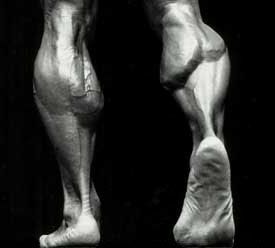Cramps: Muscle cramps explained
 Don’t you love it?! It’s 1.24am and you are out of bed in a flash with a crazy cramp in your right calf. Who knew you could get up so fast!
Don’t you love it?! It’s 1.24am and you are out of bed in a flash with a crazy cramp in your right calf. Who knew you could get up so fast!
What are muscle cramps?
A cramp in one of your muscles is simply an involuntary contraction. By involuntary I mean that without your instruction the muscle simply chooses to contract. Without your intervention the contraction becomes painful.
What are the common ones?
The most common muscle to experience cramping is the calf in the lower leg. More specifically the gastrocnemius muscle of the calf.  And even more specifically, the inner (medial) of the two heads of the calf. If you look at the black-and-white pic of my leg (ha!) then the two heads of muscle are the gastrocnemius. It is the inner of these two heads that cramps most commonly.
And even more specifically, the inner (medial) of the two heads of the calf. If you look at the black-and-white pic of my leg (ha!) then the two heads of muscle are the gastrocnemius. It is the inner of these two heads that cramps most commonly.
Secondly, the hamstring muscles in the back of your thigh are a common culprit. Any skeletal muscle in your body can cramp in theory, it just tends to be those longer muscles with free borders like hamstrings, calves, biceps and quadriceps that are most commonly affected.
What causes them?
Cramps are usually a combination of factors. As I list them, you may find you need to address one or two of these areas to solve cramping. I have listed these in order of importance.
Dehydration:
When skeletal muscle is dehydrated it is far less efficient and prone to cramping, not to mention more post exercise soreness, slower recovery and more.
Fatigue:
Fatigued muscles that are cooling down post exercise, trying to recover from the stairs you just ran, are the most likely to cramp.
Cold:
Ever shivered when you were cold? Shivering is a rapid involuntary contraction of muscle that is attempting to increase blood flow and warm up. Doesn’t it make sense that cold muscles will want to contract more readily? Cold can trigger cramps.
Nutritional inadequacy:
If your vitamin, and more particularly your mineral intake, is poor your skeletal muscle is simply not getting all the tools it needs to function, rest and repair. It is the skeletal muscle that gets its supply of nutrition last because there is plenty of it and it is not as important as your brain or liver. So when the body says not enough magnesium this week, it ain’t the liver that will miss out. It is your skeletal muscle. As a result, you only need vitamin or mineral inadequacy to prompt skeletal muscle problems. Check out What have vitamins got to do with my sore foot? or How do vitamins heal my pain? for more on this.
Nerve compression:
A less common cause is nerve compression. Nerves are the transmission lines that tell muscles whether to contract or relax. If you have some compression or interference to a nerve then the muscles that are supplied by that nerve are more likely to cramp. A good example would be mild nerve compression in the lower back contributing to cramps in muscles in the leg.
How do I fix a cramp at the time?
In a word: stretch.
When a muscle cramps it is shortening without restraint. To prevent the cramp continuing you need to do the opposite. You need to lengthen the muscle. Simple rule of thumb: whatever way the limb is going, pull it in the opposite direction. If the ankle is flexing down, toes down, pull it back the other way. If the hamstring is bending the knee then straighten it.
Forcefully lengthening a cramping muscle can be painful, so go gradually, but this is what has to happen.
How do I prevent them from reoccurring?
For the majority of readers, you will be able to relate to a few of the causes listed above.
So if you are exercising drink plenty of water. Know that as your body cools muscles will want to cramp so cover up, stay warm. Realise that as your muscles are fatigued and recovering, this is most likely when they will cramp. So yes, when you jump into bed at night after your marathon stair sprints four hours earlier and you are waiting for the doona to warm up and you get that killer cramp, now you know why. The muscles are fatigued and in recovery mode, you didn’t drink enough water and you’re cold.
As for increasing magnesium in your diet, opt for dark leafy greens and nuts and seeds. Upping your calcium intake may help too!
Hope this has been super helpful. Get out there!
– Tim


